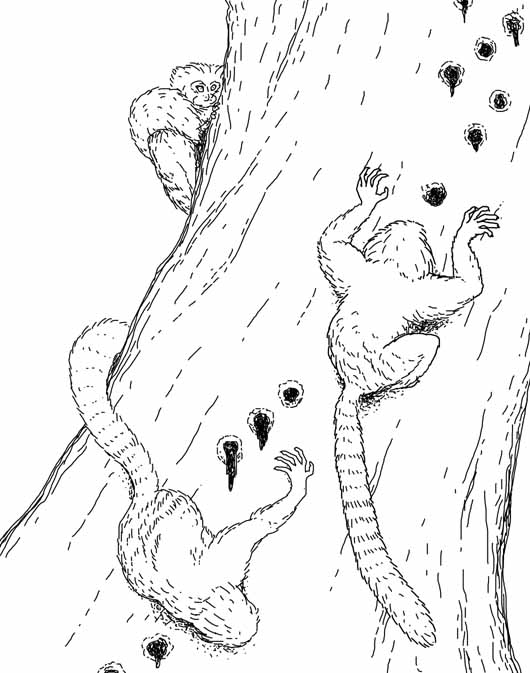After a long hiatus, I bring you another installment of “Meet a Contemporary.” Yayyyyy. School’s out now, so this blog should pick up a bit.
Meet Callitrhix (sometimes Cebuella) pygmaea, or the pygmy marmoset, a contender with the gray mouse lemur, lesser galago, and pygmy tarsier for smallest living primate. They’re cute little buggers and often kept in private homes as pets in the West (not a practice primatologists are favorable towards). For those two reasons, the pygmy marmoset might well be familiar to the reader.

Awww.
Pygmy marmosets are New World monkeys of the Family Callitrichidae along with other marmosets of the genus Callithrix, tamarins (Sanguinus and Leontopithecus), and sometimes Geoldi’s monkey (Callimico). All Callitrichids are notable for their small body size, squat legs, keeled nails resembling primitive mammalian claws, and squirrel-like habits of locomotion with lots of clinging to vertical trunks, leaping between them, and running on all fours across branches. They also frequently give birth to fraternal twins (which may be due to ecological factors related to r-selection or may simply be a compensating feature for the small size of the marmoset’s birth canal).

C. pygmaea in profile. Note the long tail, claws, short legs, and other squirrel-like features.
As if often the case with primates, the fine systematics come down to teeth. Marmosets and tamarins have both lost their last molars (wisdom teeth) as a function of their reduced snout length, giving them a dental arcade of 2 incisors, 1 canine, 3 premolars, and 2 molars in each cheek. This is a unique configuration among the primates (humans also routinely fail to develop third molars, but have only 2 premolars). The marmosets’ upper molars are also much simpler and more “primitive” in appearance than other monkeys’, leading some researchers (such as Philip Herskovitz, who literally wrote the book on New World Monkeys) to believe that they are close to the ancestors of the New World primates. Other authorities feel them to be secondarily derived.
Marmosets and tamarins are distinguished from each other by the size and shape of their canines. Tamarins are so-called “tusked,” with long, sharp canines, while marmosets (including the pygmy variety) have very short, pointy ones. Marmosets subsist on insects and heavily on tree exudates (i.e. sap and gum), which they excite by jabbing their canines and lower incisors into the bark of the trunks which they cling to with their claws.

Upper dentition of the common marmoset (C. jacchus). Three premolars are the mark of a New World monkey, the two molars are unique to the Callitrichidae. The dental formula is 2-1-3-2.


Comparison of the skulls of the C. jacchus and the cotton-top tamarin (S. oedipus). Note the difference in canine size. From the Glendale Anthropology Dept. Skull Gallery.
Pygmy marmosets make particular use of their claws because their extremely small size prevents them from grasping large trunks or branches in the manner of other primates with their hands or arms. They have to cling vertically and then leap from tree to tree. Pygmy marmosets average 13.6 cm (5.4 in) in length excluding the tail (20.2 cm long) and weigh just around 130 g (4.4 oz) but can leap up to 5 m. So if you’re ever in the forests of western Brazil, eastern Peru and Ecuador, or southern Columbia, I suppose you should watch your head for tiny monkeys hurtling past.

Range of C. pygmaea from Primate Info Net
Marmosets are notoriously variable in their social and mating systems, both from species to species and even within populations. Pygmies, however seem to be relatively boring by marmoset standards. The typical group includes a male, female, and offspring, with occasionally a non-dominant male who the dominant male attempts to prevent from mating with the female. There is minimal difference between the sexes in size. The groups occupy a territory centered around an ‘exudate tree’ which they tap in a pattern moving up the trunk. When a tree is exhausted, the group moves on. They usually maintain a handful of sleeping sites in their territory but will only routinely occupy one. They days are divided between exudate feeding in the morning, social activity and insect foraging in the middle of the day, and then more exudate feeding until bedtime.

C. pygmaea vertically clinging and feeding on tree exudates from www.loris-conservation.org
The question that beacons in any conversation about C. pygmaea is “why so small?” Normal explanations for dwarfism such as isolation on islands or in otherwise cut-off ecosystems seem not to apply here. Marmosets are generally under what is known as an r-selective regime, or selection for high reproductive capacity. They suffer heavy predation and in order to recoup their numbers they reproduce abundantly (for a primate) with twin births and reach sexual maturity sooner by truncating their size and development, yet the common marmoset and the pygmy marmoset have the same average lifespans (11.7 y) but with pygmies taking twice as long to reach sexual maturity (2 y) and first reproducing at about the same time (22 mo). So the only explanation I can offer is that pygmy marmosets are small bodied for some ecological reason that I can’t seem to find in the literature. Sorry, that’s not much of a conclusion. But they are cute, aren’t they?
References
Cawthon Lang KA. “Primate Factsheets: Pygmy marmoset (Callithrix pygmaea) Taxonomy, Morphology, & Ecology.” June 30 2005. <http://pin.primate.wisc.edu/factsheets/entry/pygmy_marmoset>
Fleagle, John G. Primate Adaptation and Evolution. 2nd ed. 1998. Academic Press.
Rowe, Noel. The Pictorial Guide to the Living Primates. 1996. Pogonias Press.